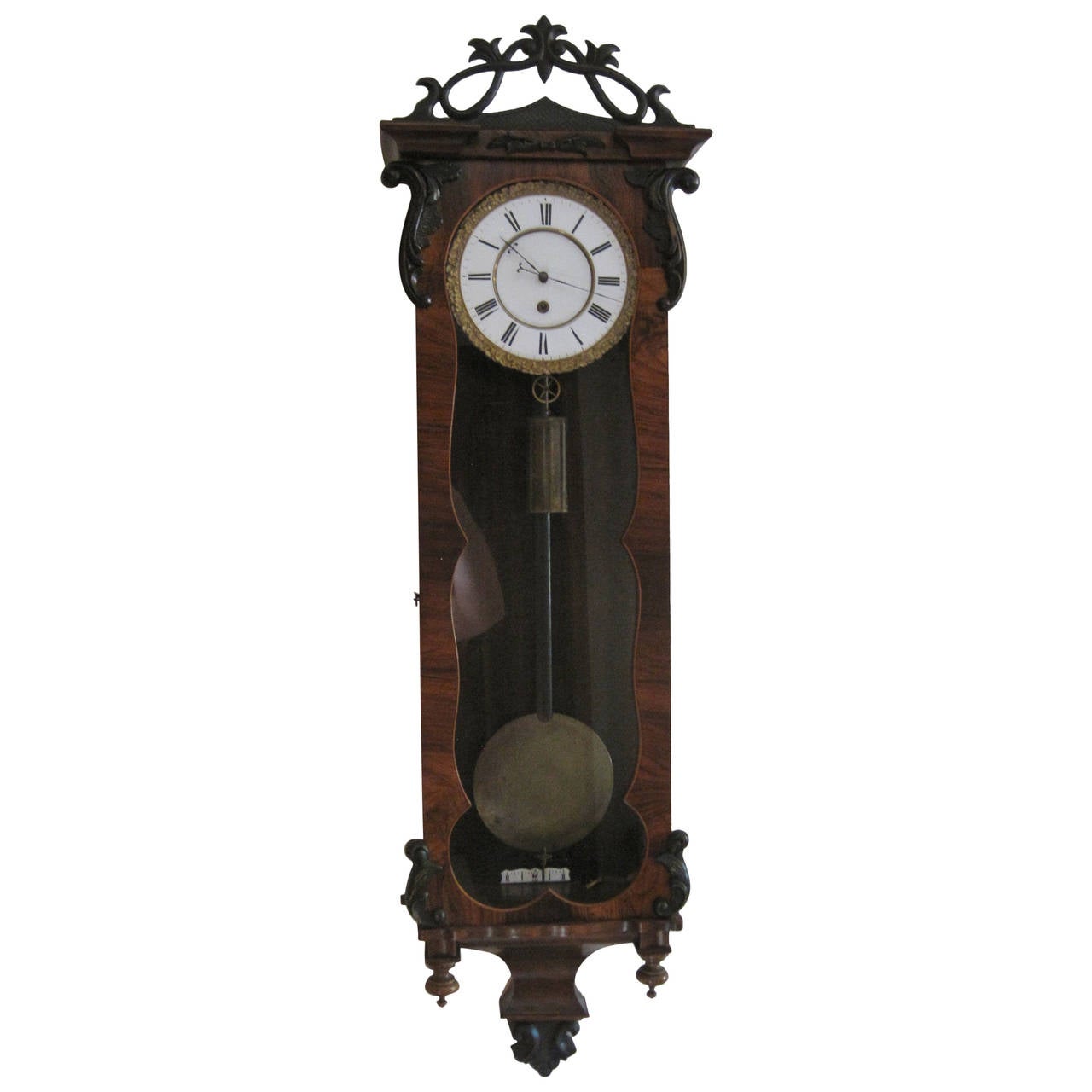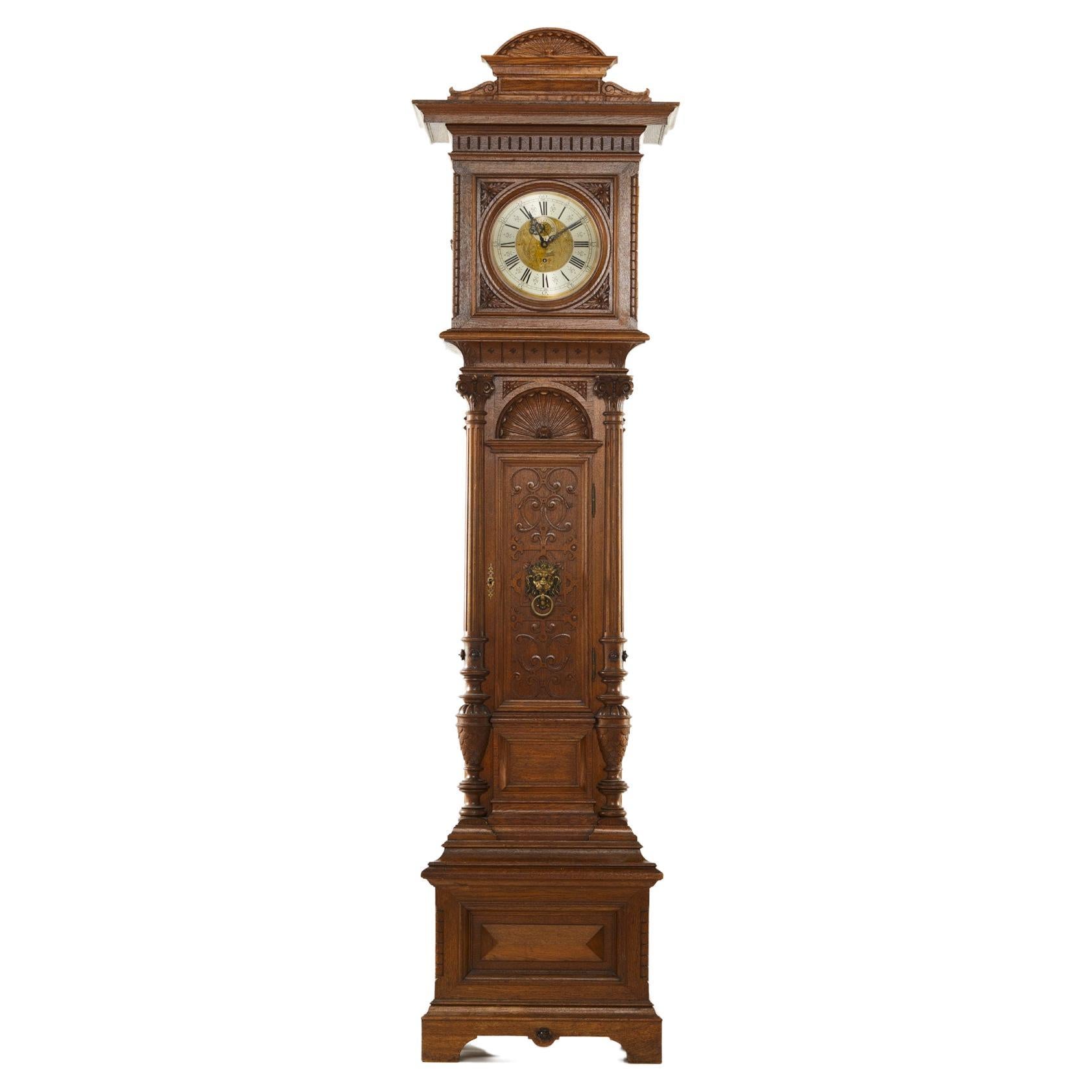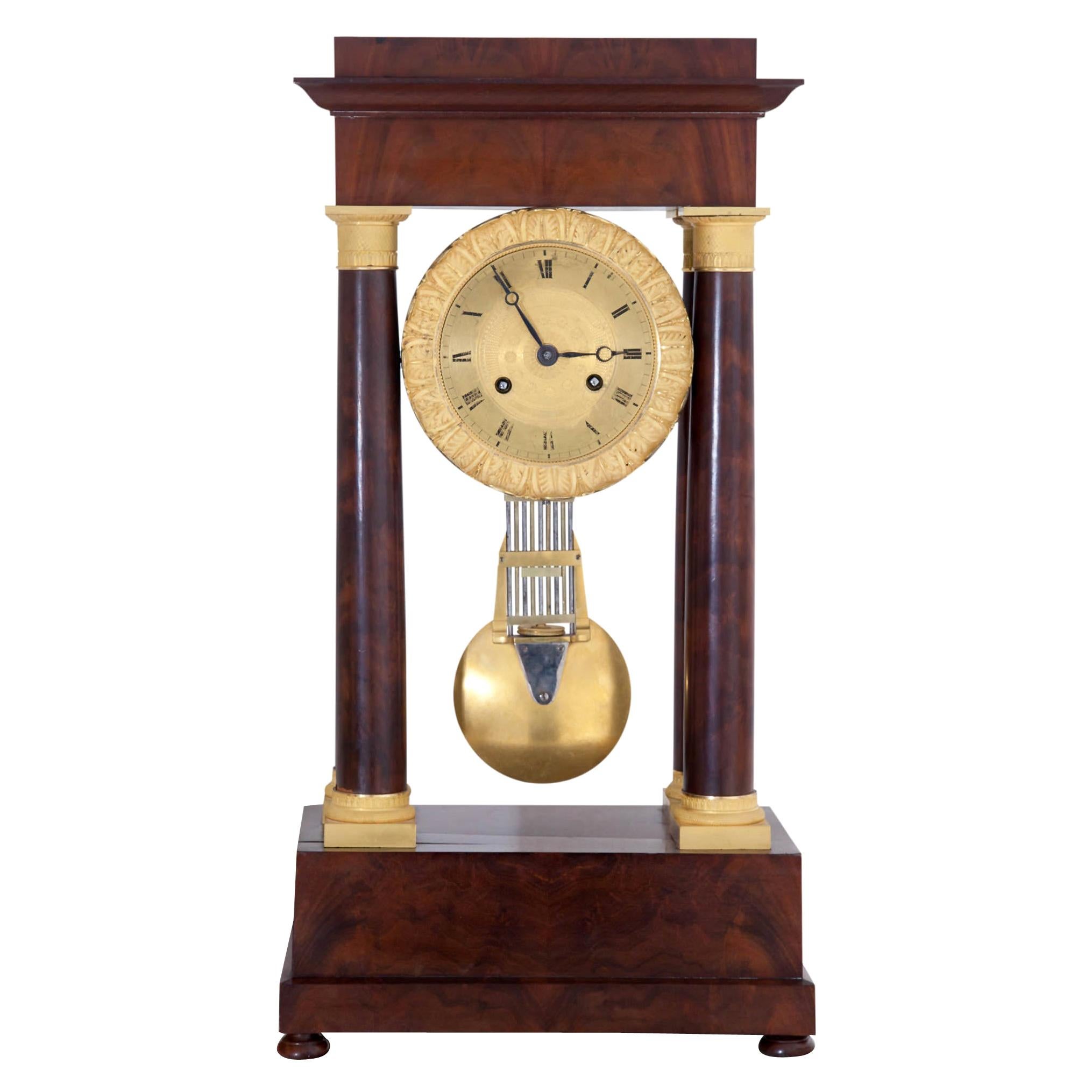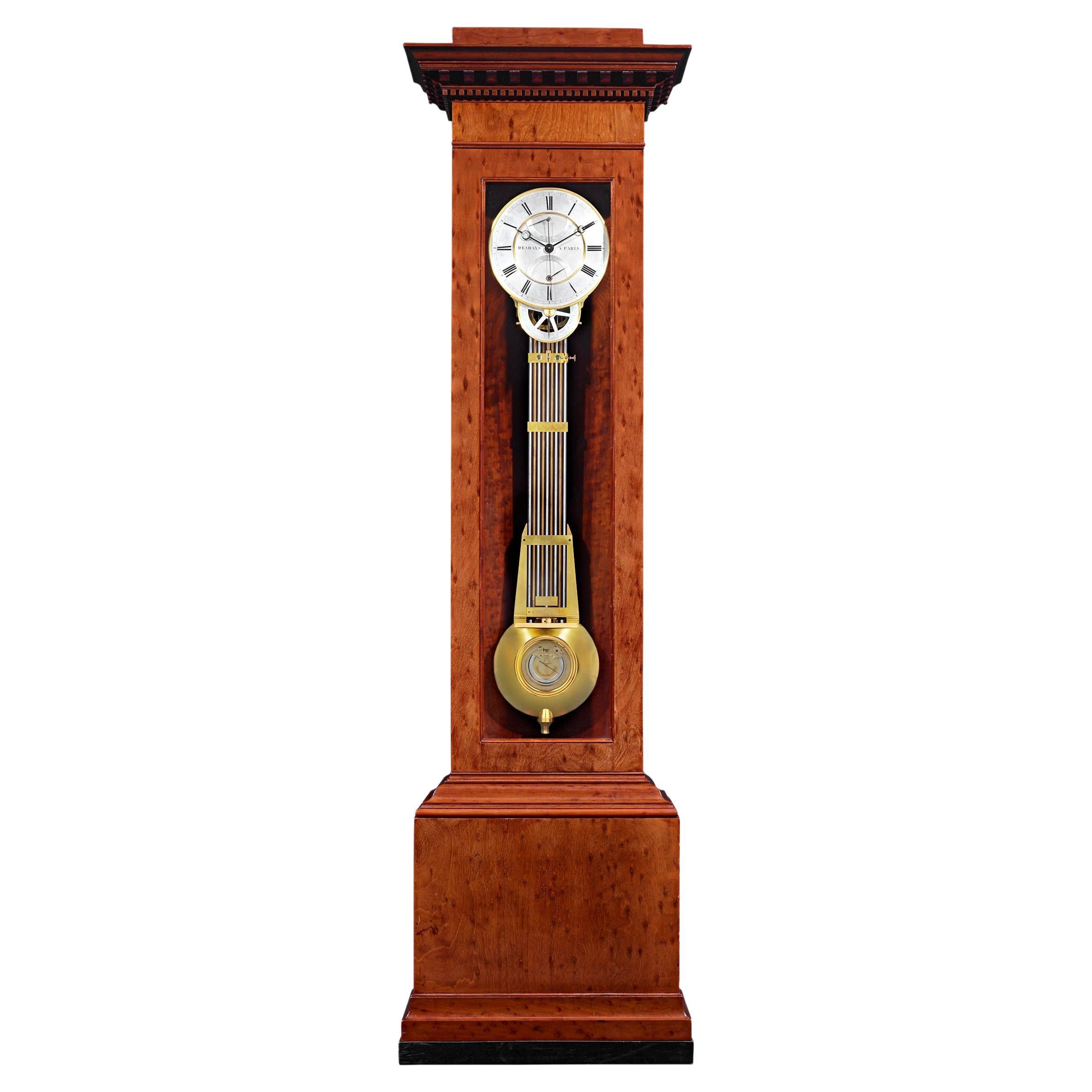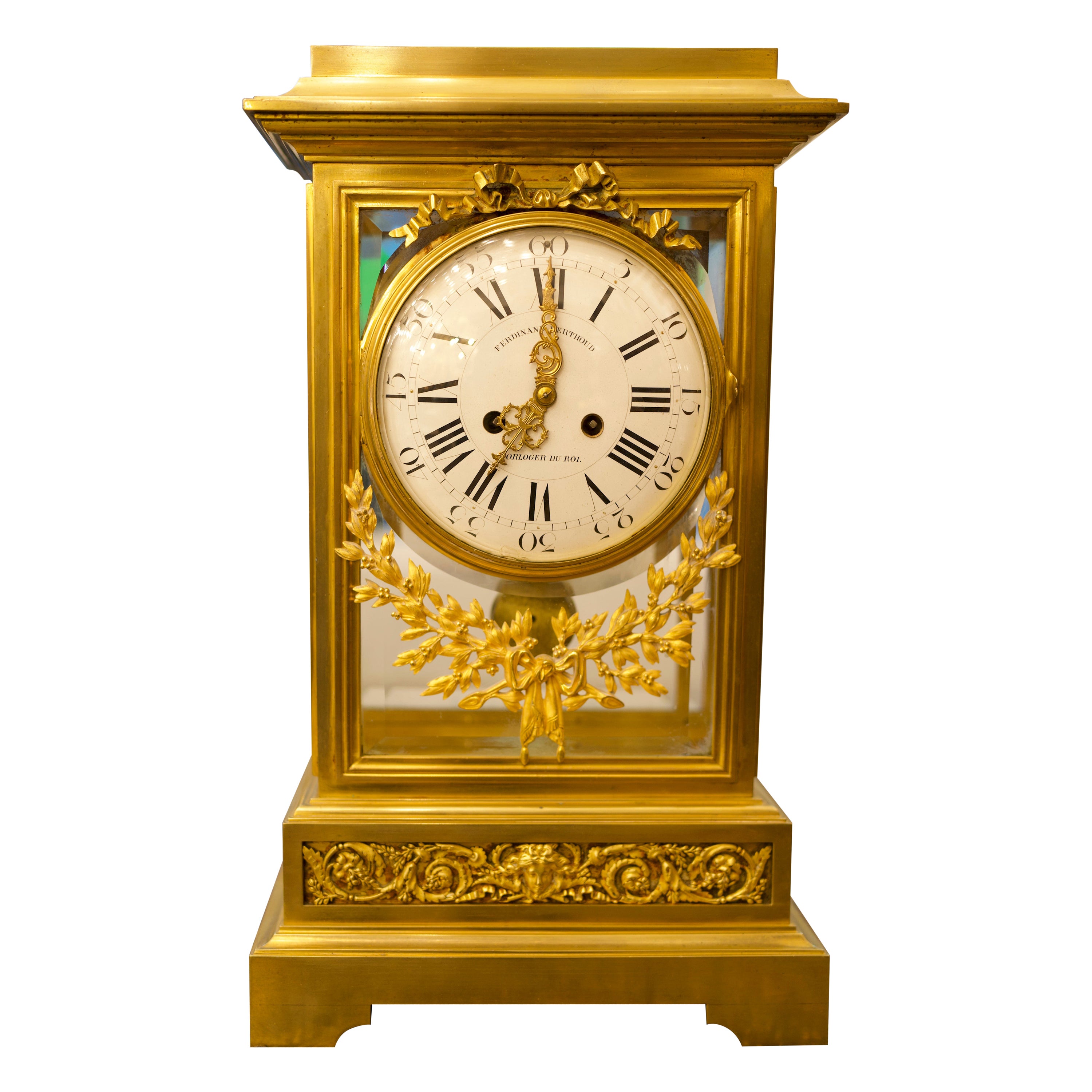Items Similar to 19th Century Regulator by Tarault Jeune, Precision Portal Clock, Paris, c. 1825
Want more images or videos?
Request additional images or videos from the seller
1 of 20
19th Century Regulator by Tarault Jeune, Precision Portal Clock, Paris, c. 1825
About the Item
Table regulator - Precision portal clock
Paris
mahogany, bronze, enamel
around 1825
Dimensions: H x W x D: 49 x 28 x 15 cm
Description:
Antique precision portal clock from the 1820s.
The round arch in which the movement is mounted is supported by solid columns. The neatly laid mahogany veneer contrasts beautifully with the finely crafted and fire-gilded bronze parts.
The clockwork is a French pendulum movement with scissor escapement, locking plate striking mechanism and compensation pendulum with blade suspension. It comes from the Tarault Jeune workshop, which, according to Brian Loomes - Watchmakers and Clockmakers of the World, is documented from 1807-1826 in the Rue St. Denis in Paris.
The power reserve is 21 days.
The white enameled dial ring with black minute track, half-second division and Roman hour numerals is framed by a wide bezel decorated with palmettes. The central area of the dial is finely guilloché and fire-gilded. Here we also find the engraved signature: Tarault Jeune á Paris.
The time is displayed by blued steel hands - Breguet hands for the hours and minutes and a simple straight hand with a crescent-shaped counterweight for the seconds.
Interesting facts:
The compensation pendulum, here designed as a rust pendulum, compensates for rate inaccuracies caused by temperature fluctuations.
The nine rods of the pendulum rod are alternately made of brass and steel. Thanks to the clever arrangement of the rods, which move in opposite directions when the temperature fluctuates, the pendulum bob always remains at the same height regardless of the temperature. As the pendulum is always the same length, the running speed remains largely stable.
Due to its extremely small contact surface, the blade suspension enables an almost frictionless oscillating movement. The pendulum's pivot point, which is precisely defined on the cutting edge, allows the most accurate calculations to be made for gear correction. One of the photos shows the upper end of the pendulum without the back cover. The minimal contact surface in the blade suspension is clearly visible in this photo.
The pendulum can be adjusted by means of a knurled screw. It allows even the slightest misalignment to be compensated for where the clock is set up.
Condition:
The movement has been dismantled and cleaned from top to bottom. It runs reliably and accurately. The case and the bronzes have also been cleaned and are in beautiful and authentic condition.
Table regulators by Tarault Jeune were sold at Sotheby's New York in October 2018, as well as at Christies New York in January 1970 and October 1996.
Please compare the following literature:
Derek Roberts - Precision Pendulum Clocks p. 99 Fig. 31-14A
- Dimensions:Height: 19.3 in (49 cm)Width: 11.03 in (28 cm)Depth: 5.91 in (15 cm)
- Style:Restauration (Of the Period)
- Materials and Techniques:
- Place of Origin:
- Period:
- Date of Manufacture:1825
- Condition:Wear consistent with age and use. The movement has been dismantled and cleaned from top to bottom. It runs reliably and accurately. The case and the bronzes have also been cleaned and are in beautiful and authentic condition.
- Seller Location:Greven, DE
- Reference Number:1stDibs: LU5419238495702
About the Seller
5.0
Platinum Seller
These expertly vetted sellers are 1stDibs' most experienced sellers and are rated highest by our customers.
Established in 2014
1stDibs seller since 2020
114 sales on 1stDibs
Typical response time: <1 hour
- ShippingRetrieving quote...Ships From: Münster, Germany
- Return PolicyA return for this item may be initiated within 14 days of delivery.
More From This SellerView All
- Late 19th Century Carriage Clock, Travel Clock, Pendulette de Voyage, Paris 1890Located in Greven, DEDimensions: H x W x D: 16 x 9 x 7 cm The height is measured with handle. Without handle it is 12 cm in height. Beautiful antique carriage clock...Category
Antique Late 19th Century French Carriage Clocks and Travel Clocks
MaterialsBrass
- Early 19th Century Mantel Clock, Firegilt Bronze, Paris circa 1810Located in Greven, DEVery rare "Au Bon Sauvage" mantel clock France Fire-gilt and patinated bronze Empire around 1810 Dimensions: H x W x D: 34 x 41 x 13 cm Description: Extremely rare French bronze m...Category
Antique Early 19th Century French Empire Mantel Clocks
MaterialsBronze
- Early 19th Century Ormolu Mantel Clock, Atala freeing Chactas, Paris, circa 1810Located in Greven, DEMantel Clock "Atala and Chactas" Paris Bronze (fire-gilt and patinated), enamel Empire around 1810 Dimensions: H x W x D: 40 x 32 x 11 cm Description: Very rare and extremely high quality French mantel clock, so-called Pendule Au Bon Sauvage. Depicted are scenes from the love story "Atala or the love of two savages in the desert" written by Francois René Vicomte de Chateaubriand in 1801. At the beginning of the 19th century, this was probably the most famous love story in Europe, but today it has been forgotten. The story, set in present-day Louisiana (USA), is roughly rewritten about the forbidden love between Chactas, a young Indian, and Atala, the beautiful daughter of a Spaniard. Chactas is captured in a battle between two Indian tribes, chained to a palm tree and is to be sacrificed. Atala wants to save his life and convert him to Christianity. She unties him from the palm tree at night and they flee together into the wilderness of North America. Their love for each other grows stronger and stronger and they have prospects for a future together. The story takes a tragic turn when Atala, who must remain a virgin due to a vow made by her mother, can no longer withstand the conflict of her feelings and commits suicide. The main group of characters thus shows Chacta's liberation through Atala. Atala is leaning against a pile of logs. The animal fur thrown over the logs and the weapons leaning against the stack on the right give the impression of a night camp. The bronze is of rarely beautiful quality, finely chiselled and makes the scene appear very lively. The contrast of fire-gilded and patinated bronze adds tension to the composition. In the base we see the Entombment as the end of the tragic love story. This bronze work is also very detailed, the interplay of bright and matt gilding makes the flat relief appear much deeper than it is. The depiction of the mantel clock presented here shows that the exotic was only known from stories and that the bronzier had his own ideas about the appearance of this distant world. The Indian, for example, has very European facial features and his skin was not black in reality, of course. The palm tree was also certainly not found in the North American wilderness. The heart of the clock is a French pendulum movement, integrated into the wooden pile, with an eight-day power reserve and a lock plate striking a bell on the half and full hour. The pendulum is suspended on a thread, typical of the period. The classically shaped hands, so-called Breguet hands, are also typical of the time. The enamelled dial has black Roman hour numerals, Arabic quarter hours and bears the signature: Le Roy hr. de Madame A PARIS. Interesting facts: The period from 1795 to about 1815 saw the creation of probably the most spectacular group of bronzes: The "Au bon Sauvage" pendulums - depictions of the "Noble Savage". Today's viewers react to these objects with both fascination and irritation. Enthusiastic on the one hand about the obvious quality of the detailed bronzes and the allure of the exotic, on the other hand distanced and cautious because of the possible discrimination that is suspected behind them. The ambivalence of this feeling motivates the search for the conditions of origin of these pendulums. Europeans found their new ideal of the natural man primarily in fictional and realistic travelogues about the Indians of North America...Category
Antique Early 19th Century French Empire Mantel Clocks
MaterialsOrmolu
- 19th Century Mantel Clock "Astronomy", France circa 1830Located in Greven, DEAntique mantel clock on the theme of astronomy France Bronze Charles X around 1830 Dimensions: H x W x D: 48 x 19 x 10 cm Description: Unusual and beautifully crafted bronze mante...Category
Antique 19th Century French Charles X Table Clocks and Desk Clocks
MaterialsBronze
- 19th Century French Ormolu Mantel Clock, circa 1840Located in Greven, DE19th Century French mantel clock France (Limoges) Ormolu around 1840 Dimensions: H x W x D: 37 x 22 x 10 cm Description: The bronze, cast in relief and then fire-gilded, stands on...Category
Antique 1830s French Charles X Mantel Clocks
MaterialsMarble, Bronze, Ormolu
- 19th Century Travel Clock with Repetition, Carriage Clock, Pendule de VoyageLocated in Greven, DETravel clock with repetition France Brass 19th century Dimensions: H x W x D: 11 x 7,5 x 4,5 cm Description: Small travel clock, so-call...Category
Antique 19th Century French Carriage Clocks and Travel Clocks
MaterialsBrass
You May Also Like
- Vienna Regulator Wall Clock, 19th CenturyLocated in Hamilton, Ontario19th century Vienna Regulator wall clock. One weight Vienna Regulator with ornate carved head piece.Category
Antique 19th Century Wall Clocks
- 19th Century Grande Sonnerie Vienna Regulator ClockLocated in Tarry Town, NYMid 19th century Mahogany wood / glass case grande Sonnerie three weight Vienna Regulator clock. The wall clock features a rosewood veneer with ...Category
Antique 1830s European Wall Clocks
MaterialsBrass
- 19th Century Johann Wien 90 Day Regulator ClockLocated in Tarry Town, NY19th century hand carved oak case with carved capitals on full length waist columns and bracket feet, 90 day brass time only movement with deadbeat escapement and maintaining power t...Category
Antique 1880s German Grandfather Clocks and Longcase Clocks
MaterialsBrass
- Empire Portal Clock, France, Early 19th CenturyLocated in Greding, DEPortal clock on a rectangular, stepped base in mahogany veneered with small bun feet. The stepped architrave is supported by four smooth columns, the capi...Category
Antique Early 19th Century French Empire Mantel Clocks
MaterialsBronze
- Month-Going Regulator Clock by Deshays à ParisLocated in New Orleans, LAThis Louis-Philippe-period month-going longcase regulator clock is an exceptional example of French clockmaking, and its complicated mechanism marks several different aspects of passing time. Crafted by Deshays à Paris, the timepiece displays sleek silvered steel dials that indicate the time, date, month, equation of time...Category
Antique 19th Century French Louis Philippe Grandfather Clocks and Longca...
MaterialsSteel
- 19th Century Louis XVI Style Regulator Gilt Bronze Clock by Ferdinand BerthoudLocated in Southall, GBA stunning 19th Century Louis XVI Style Regulator Gilt Bronze clock by Ferdinand Berthoud. A French Louis XVI style gilt bronze regulator clock, the finely cast rectangular case with four beveled glass sides; the large white enamel dial with Roman numerals is decorated above and below with gilt bronze garlands. The dial is signed and the stepped base is further embellished on three sides with a gilded frieze...Category
Antique 19th Century French Mantel Clocks
MaterialsBronze
Recently Viewed
View AllMore Ways To Browse
Scissor Hands Dial
Portal Clock
Antique Pendulum Table Clock
American Clock Company Clock
Rubis Clock
Aurora Prisma
Fanniere Freres
Marble Alarm Clock
Atmos 540
Twin Bell Alarm Clock
Carl Aubock Clock
Cartier Must Clock
Digital Alarm Clock Retro
Kirby Beard & Co. On Sale
Triangle Desk Clock
Vintage Electric Alarm Clock
Vintage Rhythm Alarm Clock
Alarm Clock Glow
